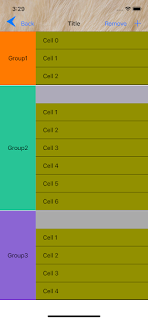import UIKit
class ShapeViewController: UIViewController {
@IBOutlet var shapingView: UIView!
override func viewDidLoad() {
super.viewDidLoad()
}
@IBAction func actionRect(_ sender: Any) {
clear()
doRectangle()
}
@IBAction func actionRoundedRect(_ sender: Any) {
clear()
doRoundedRectangle()
}
@IBAction func actionOptionalRoundedRect(_ sender: Any) {
clear()
doOptionalRoundedRectangle()
}
@IBAction func actionTriangle(_ sender: Any) {
clear()
doTriangle()
}
@IBAction func actionOval(_ sender: Any) {
clear()
doOval()
}
@IBAction func actionCircle(_ sender: Any) {
clear()
doCircle()
}
@IBAction func actionArc(_ sender: Any) {
clear()
doArc()
}
@IBAction func actionPie(_ sender: Any) {
clear()
doPie()
}
@IBAction func actionComplexShape() {
clear()
doComplexShape()
}
@IBAction func actionDonut(_ sender: Any) {
clear()
doDonut()
}
func degreeToRadian(_ degree: CGFloat) -> CGFloat {
return degree * CGFloat(Double.pi) / 180.0
}
func clear() {
shapingView.layer.sublayers?.forEach({ (layer) in
layer.removeFromSuperlayer()
})
}
// 직사각형
func doRectangle() {
#if false
let shapeLayer = CAShapeLayer()
shapeLayer.path = UIBezierPath(rect: CGRect(x: 50, y: 50, width: 100, height: 100)).cgPath
shapeLayer.fillColor = UIColor.red.cgColor
shapeLayer.strokeColor = UIColor.black.cgColor
canvas.layer.addSublayer(shapeLayer)
#else
let path = UIBezierPath()
path.move(to: CGPoint(x: 50, y: 50))
path.addLine(to: CGPoint(x: 100, y: 150))
path.addLine(to: CGPoint(x: 150, y: 150))
path.addLine(to: CGPoint(x: 150, y: 50))
path.close()
#endif
let shapeLayer = CAShapeLayer()
shapeLayer.path = path.cgPath
shapeLayer.fillColor = UIColor.red.cgColor
shapeLayer.strokeColor = UIColor.black.cgColor
shapeLayer.lineWidth = 0.5
shapingView.layer.addSublayer(shapeLayer)
}
// 모든 모서리가 둥근 사각형
func doRoundedRectangle() {
let shapeLayer = CAShapeLayer()
shapeLayer.path = UIBezierPath(roundedRect: CGRect(x: 50, y: 50, width: 200, height: 100), cornerRadius: 10).cgPath
shapeLayer.fillColor = UIColor.red.cgColor
shapeLayer.strokeColor = UIColor.black.cgColor
shapeLayer.lineWidth = 1.0
shapingView.layer.addSublayer(shapeLayer)
}
// 선택적으로 모서리가 둥근 사각형
func doOptionalRoundedRectangle() {
let shapeLayer = CAShapeLayer()
shapeLayer.path = UIBezierPath(roundedRect: CGRect(x: 50, y: 50, width: 200, height: 100),
byRoundingCorners: [.topLeft, .bottomRight],
cornerRadii: CGSize(width: 15.0, height: 0.0)).cgPath
shapeLayer.fillColor = UIColor.red.cgColor
shapeLayer.strokeColor = UIColor.black.cgColor
shapeLayer.lineWidth = 1.0
shapingView.layer.addSublayer(shapeLayer)
}
// 타원
func doOval() {
let shapeLayer = CAShapeLayer()
shapeLayer.path = UIBezierPath(ovalIn: CGRect(x: 50, y: 50, width: 200, height: 100)).cgPath
shapeLayer.fillColor = UIColor.red.cgColor
shapeLayer.strokeColor = UIColor.black.cgColor
shapeLayer.lineWidth = 1.0
shapingView.layer.addSublayer(shapeLayer)
}
// 원
func doCircle() {
let shapeLayer = CAShapeLayer()
shapeLayer.path = UIBezierPath(ovalIn: CGRect(x: 50, y: 50, width: 100, height: 100)).cgPath
shapeLayer.fillColor = UIColor.red.cgColor
shapeLayer.strokeColor = UIColor.black.cgColor
shapeLayer.lineWidth = 1.0
shapingView.layer.addSublayer(shapeLayer)
}
// 삼각형
func doTriangle() {
let trianglePath = UIBezierPath()
trianglePath.move(to: CGPoint(x: shapingView.frame.width/2, y: 0.0))
trianglePath.addLine(to: CGPoint(x: 0.0, y: shapingView.frame.size.height))
trianglePath.addLine(to: CGPoint(x: shapingView.frame.size.width, y: shapingView.frame.size.height))
trianglePath.close()
let shapeLayer = CAShapeLayer()
shapeLayer.path = trianglePath.cgPath
shapeLayer.fillColor = UIColor.red.cgColor
shapeLayer.strokeColor = UIColor.black.cgColor
shapeLayer.lineWidth = 2.0
shapingView.layer.addSublayer(shapeLayer)
}
// 호
func doArc() {
let shapeLayer = CAShapeLayer()
let path = UIBezierPath(arcCenter: CGPoint(x: shapingView.bounds.width/2,
y: shapingView.bounds.height/2),
radius: 100,
startAngle: degreeToRadian(270),
endAngle: degreeToRadian(45),
clockwise: true)
path.close()
shapeLayer.path = path.cgPath
shapeLayer.fillColor = UIColor.red.cgColor
shapeLayer.strokeColor = UIColor.black.cgColor
shapeLayer.lineWidth = 2.0
shapingView.layer.addSublayer(shapeLayer)
}
// 파이
func doPie() {
let center = CGPoint(x: shapingView.bounds.width/2, y: shapingView.bounds.height/2)
let radius: CGFloat = 80.0
let path = UIBezierPath()
path.move(to: center)
path.addArc(withCenter: center,
radius: radius,
startAngle: degreeToRadian(270),
endAngle: degreeToRadian(135),
clockwise: true)
path.close()
let shapeLayer = CAShapeLayer()
shapeLayer.path = path.cgPath
shapeLayer.fillColor = UIColor.blue.cgColor
shapeLayer.strokeColor = UIColor.red.cgColor
shapeLayer.lineWidth = 2.0
shapingView.layer.addSublayer(shapeLayer)
}
// 도넛
func doDonut() {
let centerPoint = CGPoint(x: shapingView.bounds.width/2,
y: shapingView.bounds.height/2)
let radius: CGFloat = 80.0
let lineWidth: CGFloat = 30.0
// track
let trackLayer = CAShapeLayer()
trackLayer.path = UIBezierPath(arcCenter: centerPoint,
radius: radius,
startAngle: 0,
endAngle: degreeToRadian(360), //CGFloat(Double.pi * 2.0),
clockwise: true).cgPath
trackLayer.fillColor = UIColor.clear.cgColor
trackLayer.strokeColor = UIColor.white.cgColor
trackLayer.lineWidth = lineWidth;
shapingView.layer.addSublayer(trackLayer)
// progress
let progressLayer = CAShapeLayer()
progressLayer.path = UIBezierPath(arcCenter: CGPoint(x: shapingView.bounds.width/2, y: shapingView.bounds.height/2),
radius: radius,
startAngle: degreeToRadian(270),
endAngle:degreeToRadian(135),
clockwise: true).cgPath
progressLayer.fillColor = UIColor.clear.cgColor
progressLayer.strokeColor = UIColor.red.cgColor
progressLayer.lineWidth = lineWidth
progressLayer.lineCap = CAShapeLayerLineCap.round // 양쪽 가장자리를 둥글게 표현
shapingView.layer.addSublayer(progressLayer)
// add animation to progress
let animation = CABasicAnimation(keyPath: "strokeEnd")
animation.duration = 0.5
animation.fromValue = 0.0
animation.toValue = 1.0
animation.timingFunction = CAMediaTimingFunction(name: CAMediaTimingFunctionName.linear)
progressLayer.add(animation, forKey: nil)
}
// 복잡한 모양
func doComplexShape() {
let path = UIBezierPath()
path.move(to: CGPoint(x: 0.0, y: 0.0))
path.addLine(to: CGPoint(x: shapingView.frame.size.width/2 - 50.0, y: 0.0))
path.addArc(withCenter: CGPoint(x: shapingView.frame.size.width/2 - 25.0, y: 25.0),
radius: 25.0,
startAngle: degreeToRadian(180.0),
endAngle: degreeToRadian(0.0),
clockwise: false)
path.addLine(to: CGPoint(x: shapingView.frame.size.width/2, y: 0.0))
path.addLine(to: CGPoint(x: shapingView.frame.size.width - 50.0, y: 0.0))
path.addCurve(to: CGPoint(x: shapingView.frame.size.width, y: 50.0),
controlPoint1: CGPoint(x: shapingView.frame.size.width + 50.0, y: 25.0),
controlPoint2: CGPoint(x: shapingView.frame.size.width - 150.0, y: 50.0))
path.addLine(to: CGPoint(x: shapingView.frame.size.width, y: shapingView.frame.size.height))
path.addLine(to: CGPoint(x: 0.0, y: shapingView.frame.size.height))
path.close()
let shapeLayer = CAShapeLayer()
shapeLayer.path = path.cgPath
shapingView.backgroundColor = UIColor.orange
shapingView.layer.mask = shapeLayer
// shapingView.layer.addSublayer(shapeLayer)
}
}
Source : https://github.com/myunggu/Shape



